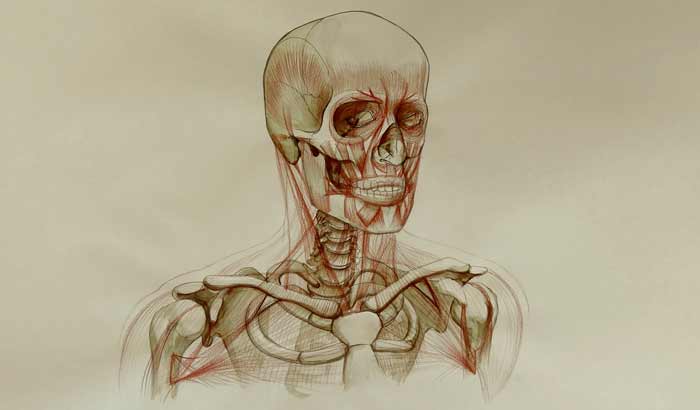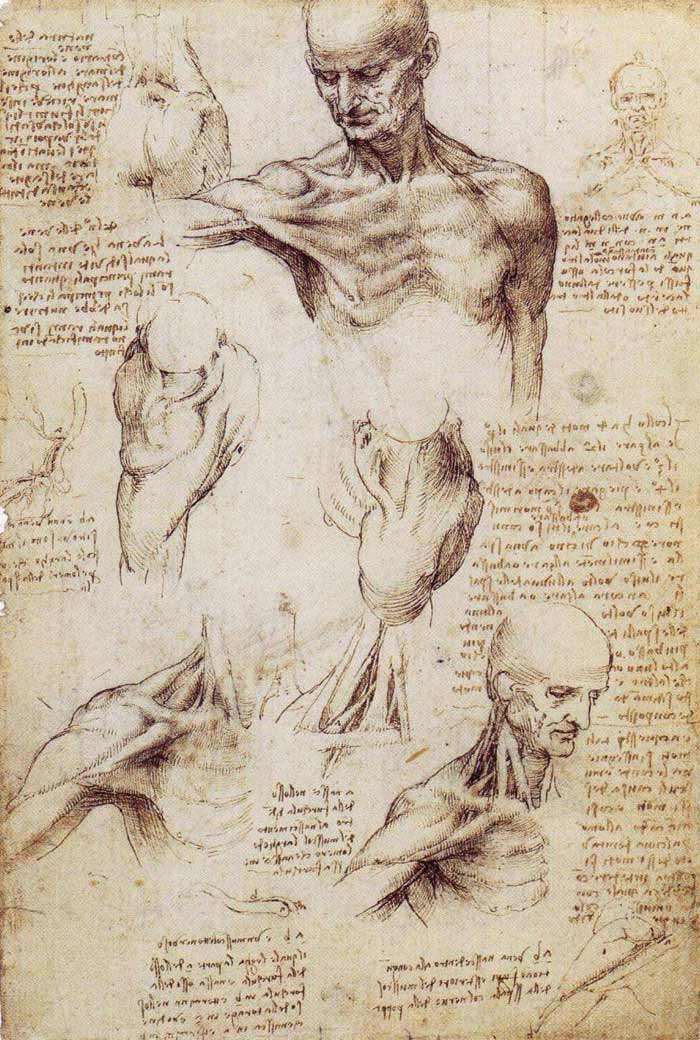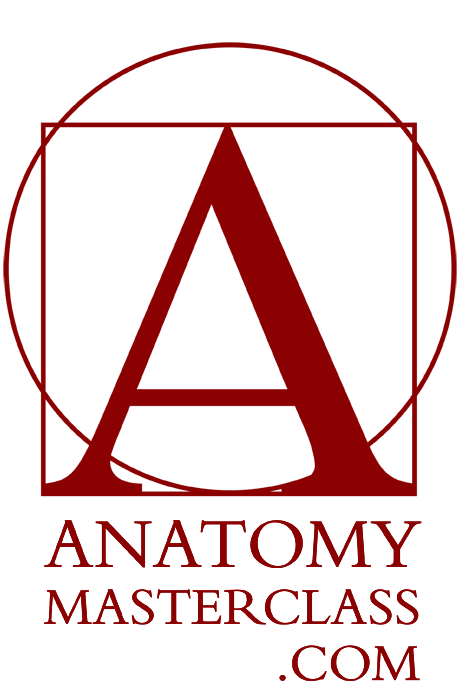Head, Neck and Shoulders Muscles
Head, Neck and Shoulders Muscles
Anatomy Lesson 6 – Part 3
In this video lesson, you will discover the main muscles of the head, neck and shoulders.
Muscles of the Head
The forehead is covered by a flat and wide muscle, called the frontalis. In fact, it is the front portion of quite a large muscle that covers the entire top and back section of the skull.
The frontalis can elevate the eyebrows, forming horizontal wrinkles on the forehead – an expression of disbelief or surprise.
When one side of the frontalis contracts, only one eyebrow is raised, expressing bemusement or distrust. When only the central part of the frontalis is engaged, a person has an expression of sadness or grief.
Just above the bridge of the nose, there is the muscle called the procerus. It has the function of lowering the inner corners of the eyebrows in expression of anger or concentration.
In the inner corners of the eyes, there is a pair of muscles that travel upward toward the eyebrows.
Nearby, there is another pair of muscles (where fibres lie more diagonally).
These two pairs of muscles contract the eyebrows, bringing them closer together. This is an expression of anger, annoyance, or intense concentration.

A human eye, mechanically, works like the lenses of a photo camera. The focus changes by adjusting the distance between the lens and the light sensitive wall of the eye. Inside the eye socket, there are four cross-shaped muscles that grip the eyeball, shortening the focus distance. There are also two additional muscles that are located in a circle and squeeze the eyeball, making this distance longer. These muscles do not influence the appearance of the human head and is described here for your general knowledge.
Around the eye, there is a disc-shaped muscle called the orbicularis oculi. It surrounds the eyeball including the eyelids.
Eyelids have a very thin skin; nevertheless, they have a thickness that needs to be depicted in a portrait to allow an eye to look realistic.
The larger portion of this muscle squeezes the eye shut, causing wrinkles at the eye’s outer corner. The portion of this muscle, that lies inside the eyelid, gently closes and opens the eyelid (a motion known as blinking).
The nose muscle nasalis has two portions.
The lower one pulls the nose downward and slightly enlarges the nose wings, while the upper one slightly compresses the nostrils. The movement of the nasalis muscles is quite subtle.
A circular shaped muscle called the orbicularis oris is the mouth muscle. It includes the upper and lower lips portions. A gentle contraction of these portions closes the lips. However, when a contraction of this muscle is more forceful, it puckers the lips tightly. The orbicularis oris helps other muscles with various movements of the lips, contributing to speech.
From each corner of this muscle, muscles that travel sideway are called the buccinators. This horizontal muscle forms the cheek. When it contracts, it pulls the lips horizontally backward. It is also called the trumpeter’s muscle as it is used when a trumpet is blown.
There is a muscle that travels from the nasal part of the upper jaw to the mouth muscle. It lifts the upper lip and the wing of the nose.
Nearby is another muscle with the similar function of lifting the upper lip. It begins under the eye socket and inserts into the mouth muscle and the wing of the nose. Together these muscles participate in expression of sneering or snarling.
Next, is the minor cheekbone muscle. This muscle originates from the cheekbone and inserts into the skin of the upper lip. Nearby, is the major cheekbone muscle, which also begins from the cheekbone and inserts into the corner of the mouth. Together, major and minor cheekbone muscles diagonally elevate the corners of the mouth during motions such as smiling or laughing.
In opposition to the muscles of happiness (that make a smile), there is the muscle that lowers corners of the mouth. It has a triangular shape and inserts into the angle of the mouth. When contracted, it presses the corners of the mouth downward in expression of disapproval or sadness.
Nearby, there is the muscle that pulls the lower lip down. It has a rectangular shape, begins at the lower edge of the lower jaw, and inserts into the skin of the lower lip. When the lower lip is drawn downward, an expression of disapproval and defiance forms.
Finally, there is the chin muscle. When contracted, this muscle pulls the chin skin upward and outward. It plays a major role in many facial expressions such as doubt, sadness, anger, or even determination.
There is a very powerful chewing muscle. It is almost square and has the purpose of closing the jaw. The reason this muscle is so powerful is because it takes quite an effort to chew. Did you know that just biting a piece of bread requires 34 kilos of force?
Between the masseter and the corner of the mouth, there is the muscle called the risorius. It pulls the corner of the mouth horizontally backward.
Next to the ear, there are three muscles that remain from our very distant past. In human anatomy, they lost their functions of turning the ear upward, forward, and backward; however, many animals have well developed these muscles and use them to their advantage (their ears can be directed toward the source of sound).
The most powerful chewing muscle is the temporalis. It is flat, fan-shaped, and begins from the temporal fossa, between the skull wall and the cheekbone arch, to the process of the lower jaw. The main function of this muscle is to close an opened jaw. It also can pull the jaw backward from its frontal position.
Muscles of the Neck and Shoulders
Now, let us examine the muscles of the neck and shoulders.


Deep inside the neck, there are muscles that lie between the neck bones, ribs, and shoulder blade. These muscles hold the neck portion of the spine in an upward position.
The trapezius muscle is located on the back of the upper ribcage and forms the back of the neck. It has a four-sided shape and assists in the extension of the neck and also moves the shoulder blade bones.
From the mastoid process of the temporal bone goes the muscle that inserts into the inner wall of the lower jaw. This muscle opens the jaw.
This muscle at the back of the neck is involved in shaking the head. It is strap-like and is positioned beneath the trapezius.
The following muscle of the neck plays an important role in head movements. It also forms the shape of the neck. Its rather long Latin name suggests that it is located between the breastbone and the base of the skull. This muscle has two portions – one starts from the breastbone and another from the collarbone. On another end, the muscle inserts into the mastoid process of the skull and the skull’s base. This neck muscle is easily detected. Between two heads that attach to the breastbone, there is the pit of the neck. This pair of neck muscles forms a “V” shape. This pair of neck muscles has the function of bending the head in various directions. When both sides are contracted, the head bends forward. When only one side is contracted, the heads flexes to the side in the direction of the engaged muscle. With the help of other muscles, this pair of neck muscles bends the head backward, and also rotates to the left and right sides.
The front surface of the neck is covered by the pair of flat muscles that covers the previous pair previously described. It is located between the collar bones and the lower jaw.
Every figurative artist must also know another important muscle called the biceps brachii. It has two heads that connect to the shoulder blade. The long head travels via the bicipital grove at the top of the upper arm bone, and the short head is connected to the coracoids process of the shoulder blade. This is the main muscle that bends the arm.
Between the ribs, there are outer and inner intercostals, which are muscles that form the walls of the ribcage.
One more important muscle of the shoulder region that you must know is called the deltoid. It has a triangular shape and its name comes from the fourth letter of the Greek alphabet called delta. This muscle resembles a triangle. The deltoid is quite a powerful muscle and has the function of raising the arm and rotating it forward and backward. It has three portions. The front section is connected to the outer half of the collarbone. The middle portion originates from the acromion of the shoulder blade. Last, the third portion is connected to the spine of the shoulder blade.
The final muscle we will examine in this video section is the large muscle of the chest called the pectoralis major. It has three portions. At the top, it travels from the middle of the collar bone and the top part of the breastbone. This portion inserts into the upper arm bone. Another portion begins from the breastbone and inserts just above the previous portion. The third portion inserts above the second dot and connects to the sixth and seventh pair of ribs.
The large muscle of the chest is very strong and moves the arm in different positions. It has three main functions – adduction (to move toward the body), flexion (to raise the part in front of the body), and medial rotation (to rotate inward).
Between the large muscle of the chest and the deltoid, there is a small triangular gap, which is approximately in the middle of the collarbone. This gap is detectable on the model’s body. For a fine artist, it serves as a landmark where the deltoid muscle ends and the breast muscle begins.
[ The full lesson is avaibale to Anatomy Master Class members ]
To learn more about Head, Neck & Shoulders Muscles, enrol in the Anatomy Master Class
Simple Pricing, No Surprises
One-time payment - Only $97 USD
ENROLL NOW



